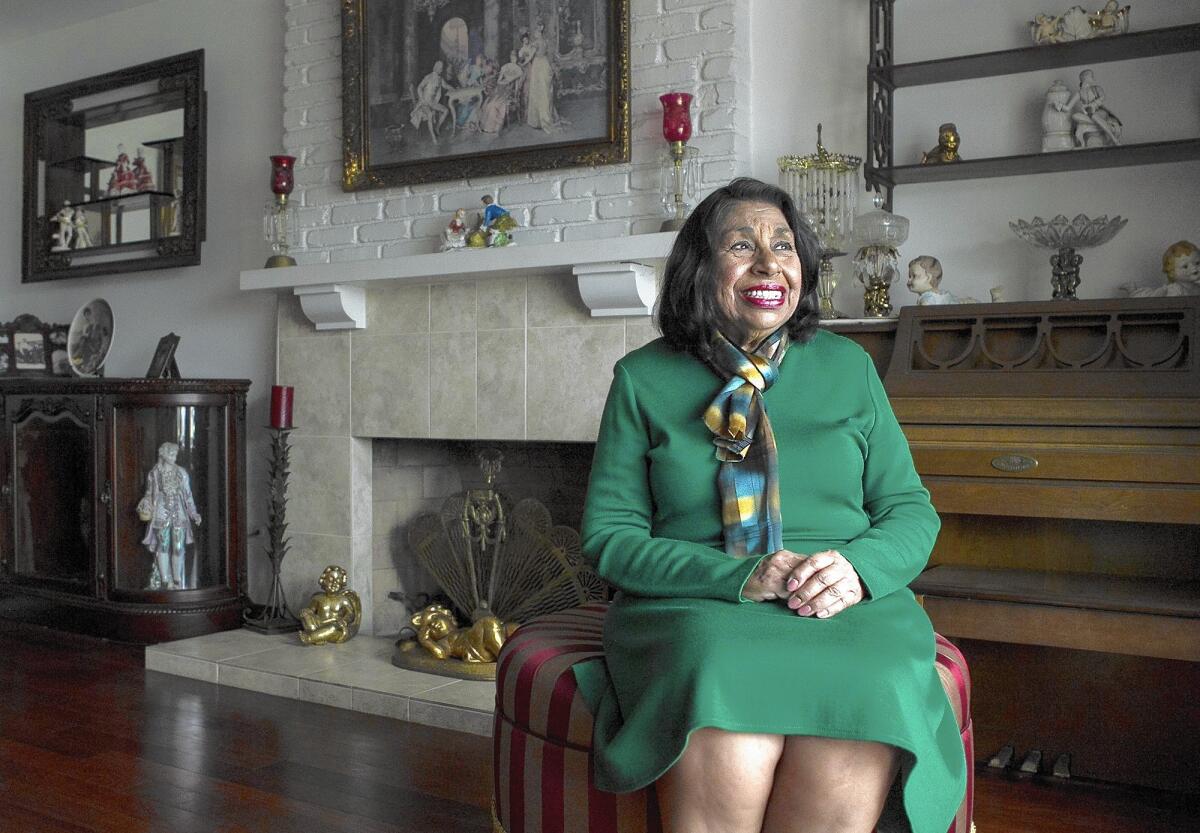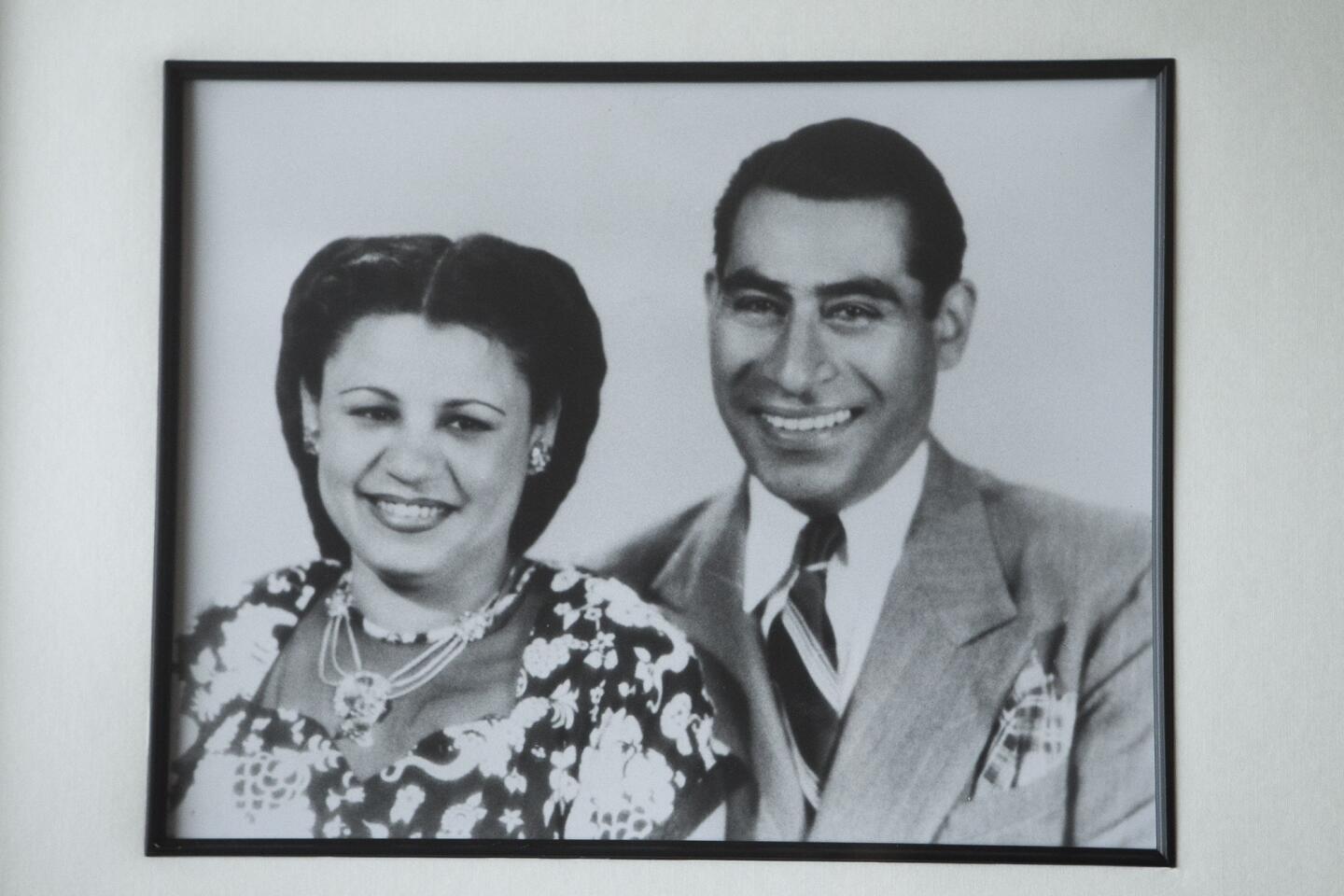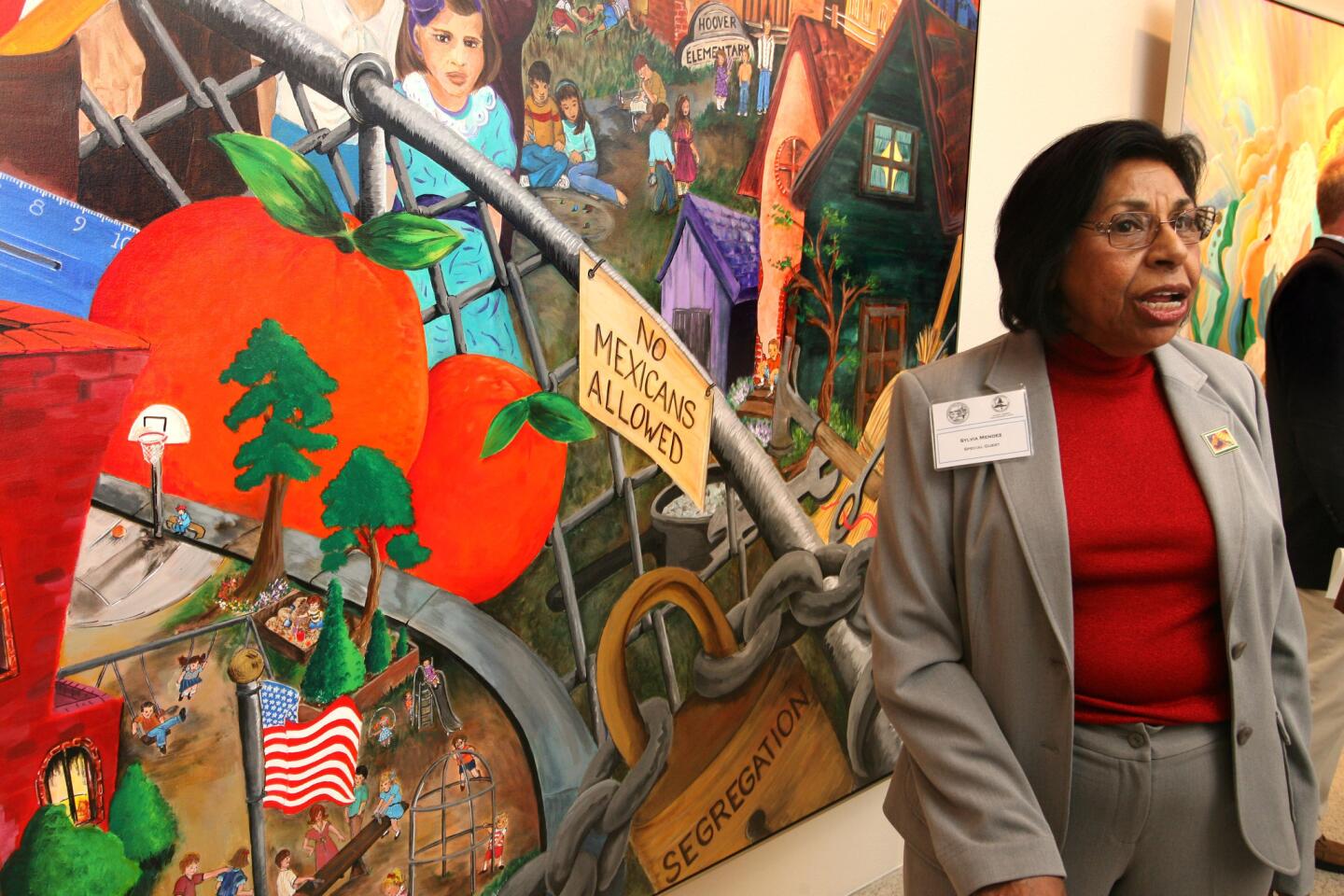Mendez vs. segregation: 70 years later, famed case ‘isn’t just about Mexicans. It’s about everybody coming together’

As a child, Sylvia Mendez thought her parents’ court case was all about a playground.
That’s because in 1944, the school bus would drop her off at the white school, which had “manicured lawns” and a “beautiful playground,” but she wasn’t allowed there. Instead, she would have to keep walking down the street to the Mexican school — two wooden shacks on a dirt lot next to a cow pasture.
“We went to court every day, I listened to what they were saying, but really I was dreaming about going back to that beautiful school,” Mendez said.
But it wasn’t a playground that Mendez’s parents, Gonzalo and Felicitas, were fighting for.
It was racial equality.
The Mendez family won the landmark Orange County case, “Mendez, et al vs. Westminster School District of Orange County, et al,” which laid the groundwork for school desegregation throughout California — and eventually the nation — decades before the civil rights movement captured the country’s attention.
Seventy years later, Mendez, 79, is a fierce advocate of her parents’ legacy, traveling the country to tell the story of Mendez vs. Westminster, one that weaves together historic figures like Thurgood Marshall and Earl Warren and events including the internment of Japanese Americans during World War II and the Brown vs. Board of Education Supreme Court decision.
“This is the history of the United States, the history of California,” she said. “Mendez isn’t just about Mexicans. It’s about everybody coming together. If you start fighting for justice, then people of all ethnicities will become involved.”
*
NO READING, WRITING
When Sylvia Mendez was growing up in the 1940s, Orange County was largely segregated, according to Gilbert Gonzalez, author of the book “Chicano Education in the Era of Segregation.” Public parks, swimming pools, restaurants and movie theaters were all segregated, and houses were often sold with racially restricted covenants, stipulating that the property could only be resold to whites.
“This is the general pattern throughout the Southwest where the Mexican community appeared,” said Gonzalez, professor emeritus in the Department of Chicano/Latino Studies at UC Irvine.
School segregation first appeared in Orange County in 1919, and by the 1940s, more than 80% of students of Mexican heritage were attending separate schools from whites, said Gonzalez. The so-called Mexican schools were designed to Americanize the students — speaking Spanish was prohibited — and also to train boys for industrial work and agricultural labor and girls for housekeeping.
Mendez remembers this well.
“We weren’t taught how to read and write,” she said. “We were taught home economics, how to crochet and knit.”
Mexican families pushed back against this immediately. In 1919, a group of parents appeared before the Santa Ana Board of Education to protest the construction of segregated schools — but their concerns were dismissed.
“The argument at the time was, ‘We have these schools because Mexican children have special needs,’” said Gonzalez. “‘It’s not that we don’t like them. We’re doing what’s best for them.’”
Then in 1930, a group of Mexican parents in San Diego County organized a boycott and lawsuit against the Lemon Grove School District for forcing their children into segregated schools. The parents won, and the landmark lawsuit became the first successful school desegregation case in U.S. history.
But the Lemon Grove Incident, as it came to be known, didn’t carry legal precedent for the rest of California, so segregation continued elsewhere in the state.
*
RESISTANCE TO CHANGE
The Mendez family discovered this firsthand in 1944 when they moved to Westminster to lease a farm owned by a Japanese American family who had been put in an internment camp during World War II. The Mendez children attempted to enroll at the nearby 17th Street School but were turned away, while their fair-skinned cousins with the French last name Vidaurri were accepted.
“My aunt took a Rosa Parks stand and said, ‘I’m not leaving my kids here if you don’t take my brother’s kids!’” Sylvia Mendez recalled.
Thinking the school simply made a mistake, Sylvia’s father, Gonzalo Mendez — who himself had attended the 17th Street School as a child — went to talk with the higher-ups.
“He talked to the principal and he said, ‘I’m sorry, Mr. Mendez, we don’t have Mexicans here,’” Sylvia Mendez recalled. “Then he went to the superintendant of schools for Orange County, and he said, ‘Mr. Mendez, four cities, Garden Grove, Santa Ana, Orange and Westminster, have built two schools, one specifically for Mexicans, and they have to go to that school. I do not have the power to change it. The cities have decided to do that.’”
The Mexican school she and her siblings were forced to attend was “terrible,” said Mendez. Besides the two wooden shacks, the books were “hand-me-downs” and the desks were “all falling apart.” An electric fence — which she said shocked one of her classmates — separated the school from a neighboring cow pasture.
“Every day I saw the white school with its beautiful playground,” said Mendez. “And I just dreamt about going to that beautiful school.”
Gonzalo knew he had to do something. But he didn’t know what until he read about another successful desegregation case in Riverside that challenged the rules barring Mexicans from public parks.
So he hired David Marcus, the Jewish American civil rights attorney who had won the Riverside case, to fight for his children. But Marcus wanted to take it one step further.
“Let’s not do this just for your children. Let’s do it for all the children,” Sylvia recalled Marcus telling her father. Gonzalo agreed and drove Marcus around Orange County looking for other plaintiffs who could join him in a class action suit.
Four others eventually got on board — Lorenzo Ramirez from Orange, Frank Palomino from Garden Grove and William Guzman and Thomas Estrada from Santa Ana.
The case, which argued that the four segregated school districts violated the 14th Amendment’s guarantee of equal protection, attracted attention outside Orange County. Thurgood Marshall, who at the time was chief counsel for the NAACP Legal Defense and Educational Fund, wrote an amicus brief in support of Mendez. The Japanese American Citizens League, the League of United Latin American Citizens, the American Jewish Congress and the American Civil Liberties Union also lent their support.
In 1946, Mendez won, but as a harbinger of the civil rights movement decades later, the ingrained attitudes would be another battle.
‘Don’t you know what we were fighting? We weren’t fighting so you could go to that beautiful white school. We were fighting because you’re equal to that white boy.’
— Sylvia Mendez, recalling her mother’s words on her first day at the white school in Santa Ana
Some schools in Orange County started to desegregate. In Westminster, Sylvia Mendez explained, the schools were integrated by placing all of the older children in the Mexican school and the younger children in the white school.
“The white people got so upset to see their children in that horrible school, so they went to the superintendant and they closed it down,” she said.
Other schools didn’t integrate at all.
The Mendez family moved back to Santa Ana and found that the schools wouldn’t integrate until an appeal of the case was complete. Other schools, Gonzalez said, continued their use of IQ testing as a way to justify keeping Mexican American students separate.
Gonzalo pushed back.
“My dad went to the superintendant and said, ‘I don’t care what you say, I’m taking my kids to the white school,’” Mendez said. She successfully enrolled at the white school in Santa Ana, but it wasn’t an easy transition.
“A white boy came up to me and said, ‘You’re a Mexican. What are you doing here? Don’t you know that Mexicans don’t belong?’”
Mendez recalled of her first day: “I was crying and crying, and told my mother, ‘I don’t want to go to the white school!’ And she said, ‘Sylvia, you were in court every day. Don’t you know what we were fighting? We weren’t fighting so you could go to that beautiful white school. We were fighting because you’re equal to that white boy.’”
Mendez said that was the first time she understood the full weight of what her parents had achieved.
A year later, the ruling was upheld in federal court, and within months, California Gov. Earl Warren signed legislation to desegregate schools — becoming the first state in the country to do so.
Soon, Mendez vs. Westminster would have nationwide ramifications.
THE WORK CONTINUES
After closely following the case, the National Assn. for the Advancement of Colored People, which called Mendez a “dry run for the future,” used much of the same legal reasoning in 1954 in Brown vs. Board of Education, a landmark case that declared state laws establishing separate public schools for black and white students to be unconstitutional.
Marshall argued this case before the Supreme Court, which by then included Chief Justice Warren, who wrote the unanimous decision that “separate educational facilities are inherently unequal.”
Despite the far-reaching implications of their case, the Mendez family resumed a sense of normalcy after the decision came down. Sylvia graduated from Santa Ana High School and Santa Ana College and worked as a registered nurse for 33 years. She didn’t think much about Mendez vs. Westminster — until decades later after her father died and her mother became seriously ill.
“She said, ‘It’s history of the United States, history of California,’” Sylvia Mendez recalled her mother saying. “She said, ‘Sylvia, you have to go out and talk about it!’”
While Mendez was initially reluctant to take up her mother’s request, she relented and started a nationwide effort to educate the public about her parents’ activism.
Felicitas died in 1998, just as the case started gaining recognition. In 2000, a new high school in Santa Ana was named after the family — the Gonzalo and Felicitas Mendez Fundamental Intermediate School. Westminster native Sandra Robbie produced the Emmy Award-winning documentary “Mendez v. Westminster: For All the Children” in 2002, and two years later, President George W. Bush invited the Mendez family to the White House for Hispanic Heritage Month. In 2007 the U.S. Postal Service issued a stamp commemorating the case.
And in 2011, Sylvia was awarded the Presidential Medal of Freedom by President Obama.
“When I got it I couldn’t stop crying, because I was thinking finally my mother and father are getting the thanks they deserve,” said Mendez. “This is theirs, not mine. They stood up against the establishment.”
Today, Mendez continues to do educational programs for youth across the country.
But going to so many schools has also taught Mendez that the struggle for educational equity is not just in the past.
“Brown and Mendez fought segregation by law, but now we have what’s called de facto segregation caused by poverty,” she said.
Still, Mendez hopes that teaching the public about her family’s legal victory 70 years ago will spark change — particularly for Latinos.
“The Latino students who are dropping out of high school need to know that Latinos have always fought for education,” she said. “And that’s something to be proud of.”
--




